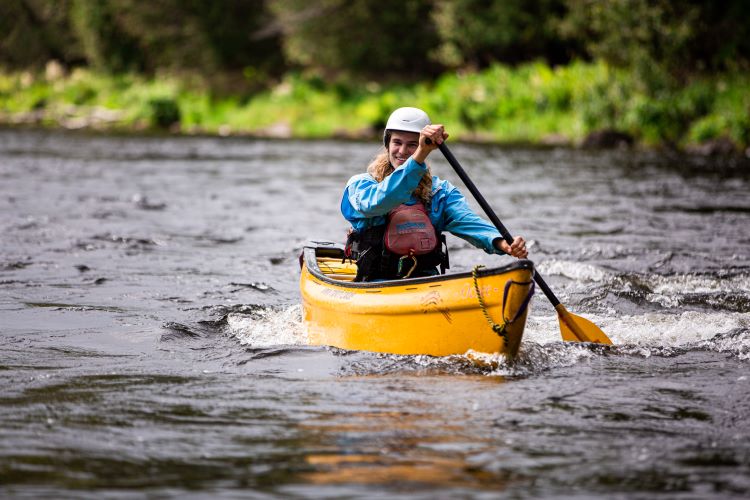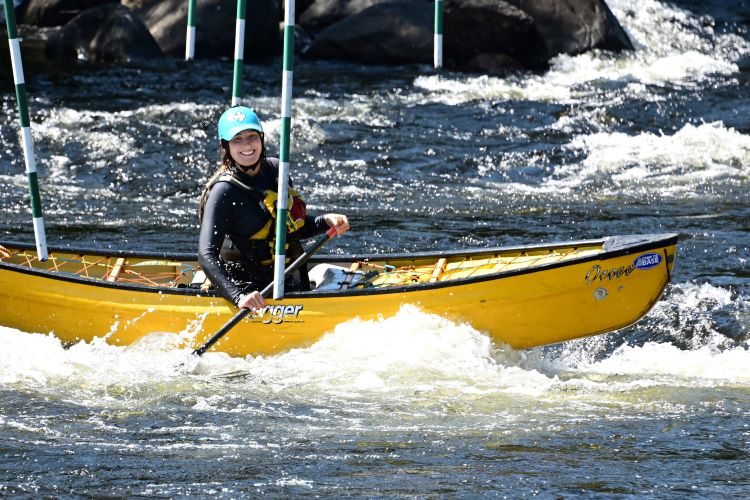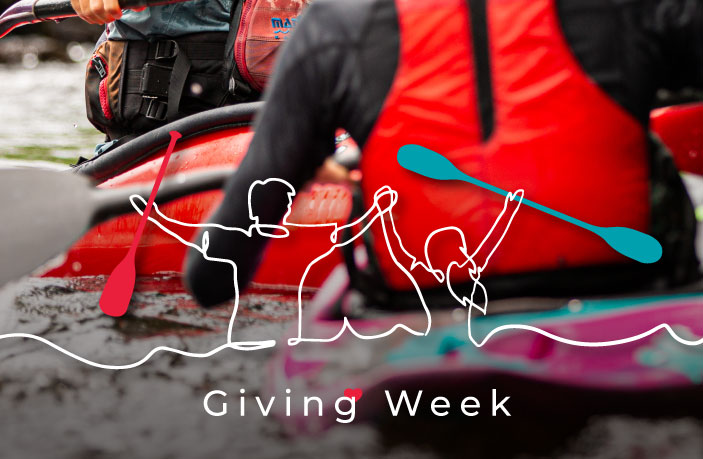Whitewater paddling is an exciting and dynamic outdoor activity that challenges kayakers and canoeists to read the language of the river. What does it mean to navigate obstacles and to work as a team? Unlike paddling on flat water, where the water’s movement is more predictable, whitewater requires an understanding of how currents interact with natural features in a river’s bed and how that will interact with your watercraft.
Learning the principles of whitewater navigation and route planning is essential for safety on the river and for your skill development as a river navigator.
Whether you are new to the sport of whitewater paddling or have years of experience, knowing how to choose the best lines or routes down a rapid, how to navigate rapids with a group of friends, and how to identify potential hazards can make the difference between a smooth ride and a challenging situation.
This guide will cover some essential techniques for helping paddlers select the safest and most efficient paths through rapids, coordinate with a group on the water, and recognize common natural hazards before they become a problem.
Reading the River and Choosing the Best Line
One of the most fundamental skills in whitewater paddling is the ability to read the river and determine the best route, or “line,” through a rapid. The water is constantly moving and changing, requiring paddlers to make quick decisions based on their surroundings. Selecting the right line is not only about efficiency but also about safety and maintaining control.
Key Factors in Choosing a Line:
- Water flow and current direction – The main current is usually the fastest-moving and smoothest section of the river. Staying within this flow will maintain momentum.
- Eddies and eddy lines – Eddies are calmer areas of water behind obstacles. These can be places where paddlers can stop, rest, and plan their next move. Eddy lines, where calm water meets fast-moving current, can be tricky to navigate and require a calculated approach.
- Obstacles and river features— Items in and around the river bed (usually rocks, banks, bedrock and ledges, but can also be trees, wood, litter or man-made objects like bridges and tunnels) all affect how water moves over and/or around them. Some features can provide fun opportunities for play, while others may be hazards to avoid.
- Downstream visibility – Always looking ahead helps paddlers anticipate upcoming obstacles and adjust their approach early. Scouting—whether from shore or from your boat—is a key to river travel success!
There are many manoeuvers that paddlers can learn to navigate rapids with more control. This includes skills like carving in and out of eddies in a series of loops, also known as an “S-turn.” You may also learn a manoeuvre known as a ferry, or ferry glide, to efficiently travel from one side of the river to the other. Often, moving from one eddy to another rather than paddling straight down the main current allows for a safer descent. This is because, by doing this, paddlers maintain better control, conserve energy, and have more time to react to obstacles.
Group Navigation: Paddling as a Team
Whitewater paddling is most often a group activity. There can be more safety and, of course, more fun in numbers. Group navigation allows paddlers to watch out for one another, provide assistance when necessary, and ensure that everyone gets the support they need to get down each rapid. This is ideal, but to have a positive experience with a large group, it takes coordinating, communication and ongoing check-ins.
Best Practices for Group Navigation:
- Assigning a lead and a sweep paddler – The lead paddler is responsible for selecting the route and setting the pace, while the sweep paddler ensures that the last people down the river are adequately supported.
- Using clear signals – Hand and paddle signals allow paddlers to communicate effectively, even over the noise of rushing water. Voices, and even the sound of whistles can be hard to understand.
- Break the rapid into sections. Instead of paddling through a rapid all at once, using eddies as stopping points can help groups navigate difficult sections with more ease.
- Use the buddy system – Empowering paddlers to take care of one another can ensure that everyone has support nearby in case of a capsize or an unexpected difficulty.
At Madawaska Kanu Centre, we build paddlers’ skills so they can work together in groups more smoothly. Instructors ensure groups can move efficiently while maintaining a high level of safety. We focus on teamwork, communication, and situational awareness to help paddlers navigate rivers confidently.
Learn more about our 5-Day Whitewater course

Recognizing and Avoiding Natural Hazards
Whitewater rivers contain many natural features that can pose risks to paddlers if improperly understood and/or improperly avoided. Recognizing hazards in advance allows paddlers to adjust their route and take necessary precautions. A River Rescue Course is an asset to any paddler- to learn about hazards, how to manage risks and practice managing various potential problems.
Common Whitewater Hazards:
- Strainers – Strainers are obstacles such as fallen trees, branches, or debris that allow water to pass through but can trap a paddler or boat. They are particularly dangerous because they can pin a person underwater.
- Hydraulics (holes) – Holes form when water pours over a drop, rock or ledge, creating a recirculating current back upstream. While some holes are playful and safe to surf, others can be difficult to escape.
- Undercut rocks and ledges—These hazards allow water to flow underneath, but not over top or around. If water is moving toward an obstacle and not ricocheting off as it should, it is likely going under the obstacle and would, therefore, trap boats or people. Undercuts are often difficult to spot from the water, which is another reason why it is important to scout ahead before running a rapid.
- Sweepers and low-hanging branches: Trees from eroded river banks often fall into the water on the outside of river bends. Overhanging trees can knock paddlers off balance or entangle them. Looking ahead downstream and moving away from the outside edges of river bends helps avoid these hazards.
- High water levels—Rapidly rising water from heavy rain or dam releases can change the river’s characteristics. Familiar eddies can be submerged, increasing the speed of currents. Often, floods wash debris into rivers, causing additional hazards. Checking water levels before paddling is crucial, as is keeping an eye on the skies, especially in tighter, narrower, and continuous sections.
Ways to Mitigate Risk:
- Develop your Skills—Enrolling in a kayak or canoe course, or a River Rescue course provides hands-on training in hazard recognition and risk management. Courses at Madawaska Kanu Centre provide experience, skills, and training in all these areas.
- Create and Communicate A Plan – Scouting- walking along the riverbank to examine a rapid- before running helps paddlers identify hazards and choose the best line. Then, create a plan for what the group does when things don’t go to plan.
- Be Prepared – Every group should have throw-ropes for each paddler, and each paddler should be skilled in and practiced in their effectiveness. Drinking water, food, First Aid Kits, warm and proper clothing, spare gear- especially paddles, Pin Kits in good working order, and emergency shelters like tarps. These are all assets for a responsible day on the river.
Planning a Whitewater Route Before Getting on the Water
Successful whitewater trips require careful route planning to ensure a smooth and safe experience. Whether paddling a short section of river or embarking on a multi-day expedition, preparation is key.
Steps for Effective Route Planning:
- Check river levels and weather conditions. Water levels can significantly change the difficulty of a rapid, so it’s important to review up-to-date conditions before heading out.
- Study river maps and guidebooks – Researching a river’s classification can be helpful, but it is just the beginning. Reach out to previous travellers of the section to prepare for what to expect.
- Identify access and exit (egress) points – Knowing all the places where paddlers could feasibly put in and take out allows for plan B and plan C decisions to be made more effectively. Identifying alternative locations where paddlers can leave the river in case of difficulty provides a safety backup.
- Match the route to the group’s skill level – Understand the entirety of the paddling group and have compassion for each paddler’s unique situation. What skills do we have? What certifications do people hold? What medical conditions and special needs?
At Madawaska Kanu Centre, whitewater courses include hands-on training in route planning, helping paddlers develop the confidence to assess and select appropriate rivers based on their skill level.
Advance Your Whitewater Skills at Madawaska Kanu Centre
Madawaska Kanu Centre is a world-class whitewater paddling centre that offers professional instruction in whitewater kayaking and canoeing. More than just a training facility, it provides a welcoming and supportive environment where paddlers of all experience levels can build confidence, improve their skills, and develop a deeper understanding of the river.
Participants in MKC courses gain practical experience in reading the river, selecting safe and effective lines, working as a team on the water, and identifying hazards before they become problems. The courses are designed for everyone, from beginners learning the basics to advanced paddlers refining their techniques.
Madawaska Kanu Centre offers five-day whitewater courses, certification courses, weekend workshops, and customized instruction tailored to individual goals.
If you are ready to improve your paddling, contact us today to learn more about our programs and how we can help you gain confidence on the river.







